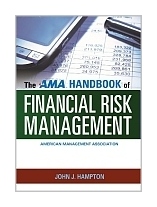If you’re involved in the financial management of your organization, you know
that every decision you make involves taking careful consideration of what factors are at
stake, and protecting your bottom line.
In short . . . managing risk.
Proper risk management entails knowing when to go after opportunities that can open up
new realms of profit for your business . . . but if you fail to account for the possible,
often hidden, pitfalls that can accompany each decision, the consequences could be
tremendous.
Filled with strategies, principles, and measurement techniques, this book provides you
with the tools you need for dealing with the most important areas of financial decision
making. You’ll learn how to reduce a complex business environment into workable concepts
and models, and quantify an enormous, constantly changing playing field in a way that
allows you to understand and predict possible outcomes and determine how your organization
should proceed in any situation.
Providing both explanations and practical applications, the book shows you how
to:
• Understand the interrelationship of risk and return
• Manage risks in capital investment decisions
• Categorize financial risks
• Analyze operating risks
• Reduce risks from cash flow and budget exposures
• Determine the value of common stock
• Optimize debt in the capital structure
This comprehensive guide gives you the essential tools and insights you
need for managing risk in financial statements, profits, cash flows, capital investments,
value of the firm, and capital structure management.
The book provides definitions of key terms, examines all the major ideas
and concepts necessary to proper financial risk management, and provides step-by-step
directions for determining risk and applying proven techniques to achieve favorable
outcomes in any given situation.
Packed with examples and “how-to” analyses, each chapter contains
financial models you can use to make sense of the numbers and provide a framework for
making smart decisions.
Authoritative, comprehensive, and clear, The AMA Handbook of Financial Risk Management
is the one book that those who make organizational financial decisions should have on
their bookshelves.
Table of Contents
Preface xi
Introduction xv
Part 1. Introduction to Financial Risk 1
Chapter 1. Categorizing Financial Risks 3
The Enterprise Risk Management Framework 3
Risk Categories 5
Financial Risk Management 14
Conclusion 16
Part 2. Accounting, Cash Flow, and Budget Exposures 17
Chapter 2. Risks from Financial Accounting 19
Overview of Accounting 19
Accounting Principles 19
Categories of Accounts 21
Trial Balance 24
Financial Statements 25
Conclusion 28
Chapter 2 Appendixes 28
Chapter 3. Managing Operating Cash Flows 33
The Cash Flow Statement 33
Cash Flow Exposures 37
Conclusion 40
Chapter 3 Appendixes 40
Chapter 4. Operating Budgets 53
Nature of Budgeting 53
Forecasting Revenues 54
Life-Cycle Stages in Budgeting 57
Risks in Revenue Forecasting 60
Expense Allocations 63
Accounting Budgets 66
Cash Budgeting 67
Details of Budgeting 70
Conclusion 72
Chapter 4 Appendixes 73
Part 3. Analyzing Operating Risks 85
Chapter 5. Profit Planning 87
Planning 87
Breakeven Analysis 89
Profit-Volume Analysis 92
Marginal Analysis 93
Future Earnings per Share 95
Conclusion 99
Chapter 5 Appendixes 99
Chapter 6. Leverage 111
Return on Investment Leverage 111
Operating Leverage 116
Financial Leverage 118
Weaknesses of Profit Planning 121
Conclusion 121
Chapter 6 Appendixes 122
Chapter 7. Financial Analysis 129
Ratio Analysis 129
Liquidity Ratios 132
Profitability Ratios 136
Other Ratios 138
Determining Financial Norms 142
Conclusion 142
Chapter 7 Appendixes 143
Part 4. Relationship of Risk and Return 149
Chapter 8. Time Value of Money 151
Short-Term Financing 151
Intermediate-Term Financing 155
The Amortization Schedule 157
Conclusion 161
Chapter 8 Appendixes 162
Chapter 9. Risk and Required Return 171
Nature of Risk 171
Capital Asset Theory 178
Risk and Required Return 181
Financial and Operational Risks 183
Conclusion 186
Chapter 9 Appendixes 186
Part 5. Nature of a Capital Investment Decision 193
Chapter 10. Capital Budgeting Cash Flows 195
Foundation of Capital Budgeting 196
Cash Flows 201
Conclusion 207
Chapter 10 Appendix 208
Chapter 11. Capital Budgeting Returns 211
Payback Method 211
Present Value Techniques 212
Internal Rate of Return Method 213
Net Present Value (NPV) Method 215
Midyear Discount Factors for Cash Flows 217
Conclusion 221
Chapter 11 Appendixes 221
Part 6. Factors That Affect the Value of a Firm 233
Chapter 12. Valuation of Common Stock 235
Common Stock and Equity Markets 235
Valuation Concepts 237
Value of Common Stock 240
Comparative Approaches to Valuation 244
Conclusion 245
Chapter 12 Appendixes 245
Chapter 13. Capital Structure of the Firm 253
Capital Structure 253
Weighted Average Cost of Capital (WACC) 254
Required Return at the Margin 257
Contribution of Miller and Modigliani 260
Optimal Capital Structure 263
Conclusion 266
Chapter 13 Appendixes 266
Chapter 14. Valuation of Business Combinations 271
Business Combinations 271
Pyramiding 273
Takeover Strategies 276
Conclusion 280
Chapter 14 Appendixes 280
Index 293
336 pages,Hardcover
Księgarnia nie działa. Nie odpowiadamy na pytania i nie realizujemy zamówien. Do odwolania !.


